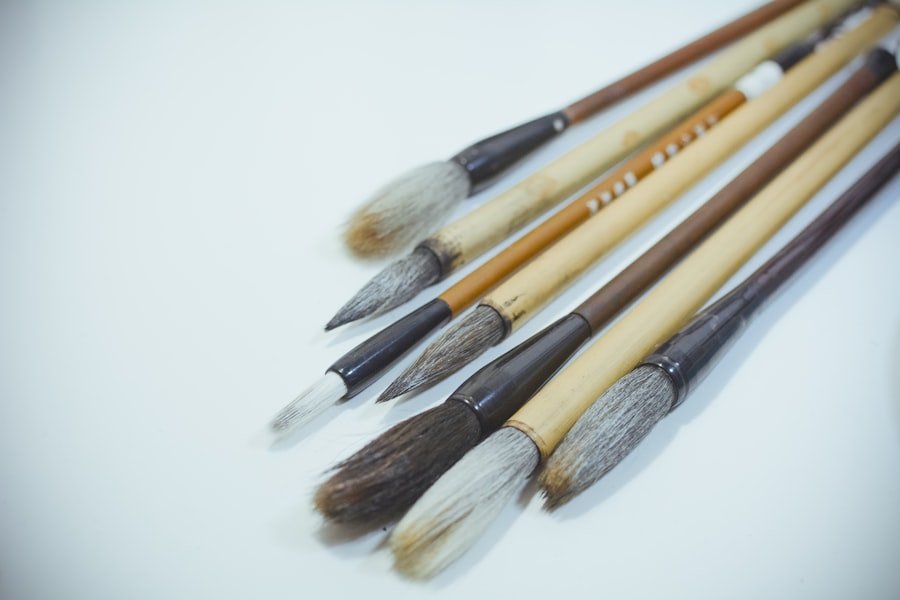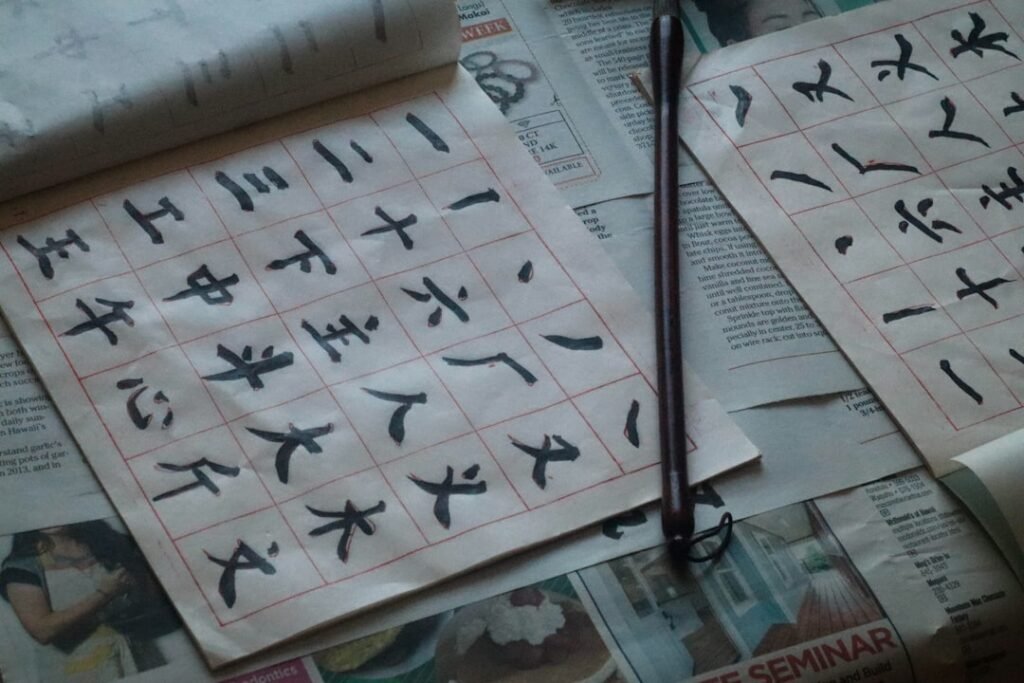Zhuan script, also known as seal script, is one of the oldest forms of Chinese writing, with its origins tracing back to the Western Zhou Dynasty (1046–771 BC). This ancient script emerged during a time when the need for a more formalised and aesthetically pleasing writing system became apparent. The earliest examples of Zhuan script can be found on bronze inscriptions, which were used for ceremonial purposes and to commemorate significant events.
These inscriptions not only served as a means of communication but also as a reflection of the socio-political landscape of the time, encapsulating the values and beliefs of early Chinese society. As the centuries progressed, Zhuan script evolved, influenced by various dynasties and cultural shifts. By the time of the Qin Dynasty (221–206 BC), Zhuan script had become standardised under the rule of Emperor Qin Shi Huang, who sought to unify the diverse writing systems across his empire.
This standardisation was crucial in promoting literacy and facilitating communication among the vast population. The script’s distinctive features, such as its elegant curves and intricate strokes, made it a popular choice for official documents and artistic expressions, solidifying its place in Chinese history. Master the art of Chinese calligraphy. Enroll now at the LC Chinese School in Oslo.
Table of Contents
ToggleSummary
- Zhuan Script, also known as Chinese Seal Script, has a long history dating back to the Shang dynasty, making it one of the oldest forms of Chinese writing.
- The unique characteristics of Zhuan Script include its square, angular shapes and intricate strokes, which give it a distinct and elegant appearance.
- Zhuan Script holds great significance in Chinese culture, particularly in art, calligraphy, literature, and poetry, where it is revered for its beauty and historical importance.
- Mastering Zhuan Script requires specific techniques and tools, such as a special brush and ink, and is an art form that continues to be practised and appreciated today.
- Contemporary artists are reviving and innovating Zhuan Script, incorporating it into modern art forms and designs, showcasing its enduring relevance and appeal.
Understanding the Characteristics of Zhuan Script: A Closer Look at its Unique Features
Zhuan script is characterised by its bold and flowing lines, which are often described as having a rhythmic quality. The strokes are typically thicker than those found in later scripts, such as regular script (kaishu), giving it a robust appearance. One of the most notable features of Zhuan script is its use of rounded shapes and angular forms, which create a sense of movement and dynamism.
This unique combination of aesthetics and structure makes Zhuan script not only functional but also visually captivating. Another defining characteristic of Zhuan script is its complexity. Each character is composed of multiple strokes that require precision and control to execute correctly.
This complexity can be daunting for beginners; however, it is also what makes mastering Zhuan script a rewarding endeavour. The script’s intricate nature encourages practitioners to develop their fine motor skills and cultivate patience, as each stroke must be executed with care to achieve the desired effect. This attention to detail is what sets Zhuan script apart from other writing styles and contributes to its enduring appeal.
The Significance of Zhuan Script in Chinese Culture: Exploring its Role in Art and Calligraphy

Zhuan script holds a revered place in Chinese culture, particularly within the realms of art and calligraphy. It is often regarded as the foundation upon which other scripts were built, making it an essential component of Chinese literary heritage. Calligraphers have long admired Zhuan script for its aesthetic qualities, often incorporating it into their works to convey a sense of tradition and cultural depth.
The elegance of Zhuan script lends itself beautifully to artistic expression, allowing calligraphers to showcase their skills while paying homage to an ancient writing style. In addition to its artistic significance, Zhuan script also plays a vital role in the preservation of Chinese history. Many historical texts and documents were inscribed using this script, providing invaluable insights into the thoughts and philosophies of past generations.
As such, Zhuan script serves as a bridge connecting contemporary society with its rich cultural heritage. By studying and practising this ancient form of writing, individuals can gain a deeper understanding of Chinese history and the evolution of its language.
Learning to Write Zhuan Script: Techniques and Tools for Mastering Chinese Seal Script
Embarking on the journey to learn Zhuan script can be both challenging and rewarding. To master this ancient writing style, one must first familiarise themselves with the fundamental techniques and tools used in calligraphy. Traditional calligraphy brushes are essential for creating the fluid strokes characteristic of Zhuan script.
These brushes come in various sizes and shapes, allowing practitioners to experiment with different styles and effects. In addition to brushes, practitioners often use ink stones and ink sticks to create their ink. The process of grinding ink from an ink stick on an ink stone is not only a practical step but also a meditative practice that connects the calligrapher with the art form.
Once equipped with the necessary tools, learners can begin practising basic strokes and characters, gradually building their skills and confidence. It is essential to approach this learning process with patience and dedication, as mastering Zhuan script requires time and consistent practice.
Zhuan Script in Contemporary Art: How Artists are Reviving and Innovating this Ancient Writing Style
In recent years, there has been a resurgence of interest in Zhuan script among contemporary artists who seek to revive and innovate this ancient writing style. Many artists are exploring new ways to incorporate Zhuan script into their works, blending traditional techniques with modern artistic expressions. This fusion not only breathes new life into an age-old practice but also highlights the versatility of Zhuan script as a medium for creative exploration.
Some artists are experimenting with mixed media, combining Zhuan script with painting, sculpture, or digital art to create unique pieces that challenge conventional boundaries. This innovative approach allows for a dialogue between past and present, inviting viewers to appreciate the beauty of Zhuan script while engaging with contemporary themes. As artists continue to push the limits of this ancient writing style, they contribute to its ongoing evolution and relevance in today’s art world.
The Beauty of Zhuan Script: Appreciating the Aesthetic Appeal of Chinese Seal Script

The aesthetic appeal of Zhuan script lies in its harmonious balance between form and function. Each character is meticulously crafted, showcasing the calligrapher’s skill and artistry. The flowing lines and graceful curves create a sense of rhythm that captivates the viewer’s eye, inviting them to explore the intricacies of each stroke.
This beauty is not merely superficial; it reflects the deep cultural significance embedded within each character. Moreover, the visual impact of Zhuan script extends beyond its individual characters. When arranged in compositions or used in larger works, Zhuan script can evoke powerful emotions and convey profound messages.
The interplay between negative space and the bold strokes creates a dynamic tension that draws viewers in, encouraging them to contemplate the meaning behind the words. This aesthetic experience is what makes Zhuan script not only a means of communication but also a form of art that resonates with people across cultures.
Zhuan Script in Literature and Poetry: Examining its Influence on Classical Chinese Literature
Zhuan script has played a significant role in shaping classical Chinese literature and poetry. Many renowned poets and writers have utilised this ancient writing style to express their thoughts and emotions, imbuing their works with a sense of tradition and cultural depth. The elegance of Zhuan script complements the lyrical quality of poetry, enhancing the overall reading experience for audiences.
Furthermore, the use of Zhuan script in literary works often reflects the philosophical ideas prevalent during different historical periods. For instance, during the Han Dynasty (206 BC–220 AD), scholars embraced Zhuan script as a means to convey Confucian ideals through literature. This connection between writing style and philosophical thought underscores the importance of Zhuan script in preserving not only language but also cultural values throughout Chinese history.
The Role of Zhuan Script in Chinese Seals: Understanding its Use in Official and Personal Seals
Zhuan script holds a prominent place in the creation of Chinese seals, which are used for both official purposes and personal expression. These seals often feature characters written in Zhuan script, signifying authenticity and authority. Historically, emperors and officials would use seals inscribed with Zhuan characters to validate documents or endorse important decisions, making them an integral part of governance.
In addition to their official use, personal seals crafted with Zhuan script have become cherished symbols of identity for individuals throughout history. These seals often bear names or meaningful phrases that reflect personal values or aspirations. The artistry involved in creating these seals showcases not only the beauty of Zhuan script but also its significance as a means of self-expression within Chinese culture.
Preserving and Promoting Zhuan Script: Efforts to Safeguard and Share this Ancient Writing Style
As interest in traditional arts continues to wane in some areas, efforts to preserve and promote Zhuan script have become increasingly important. Various organisations and institutions are dedicated to safeguarding this ancient writing style by offering workshops, exhibitions, and educational programmes aimed at raising awareness about its cultural significance. These initiatives play a crucial role in ensuring that future generations appreciate and engage with Zhuan script.
In addition to formal educational efforts, social media platforms have emerged as powerful tools for sharing knowledge about Zhuan script with a global audience. Artists, calligraphers, and enthusiasts are using these platforms to showcase their work, share tutorials, and connect with others who share their passion for this ancient art form. By leveraging technology to promote Zhuan script, advocates are helping to ensure that this rich cultural heritage remains alive and relevant in today’s world.
The Cultural Significance of Zhuan Script: Its Connection to Chinese History and Identity
Zhuan script is more than just an ancient writing style; it embodies the essence of Chinese history and identity. As one of the earliest forms of written communication in China, it serves as a testament to the evolution of language and culture over millennia. The characters crafted in Zhuan script carry with them stories from different dynasties, reflecting societal changes, philosophical developments, and artistic movements throughout history.
Moreover, Zhuan script fosters a sense of connection among individuals who engage with it today. By learning this ancient writing style or appreciating its beauty in art and literature, people can forge links with their cultural heritage while also embracing contemporary interpretations. This duality enriches one’s understanding of identity within a global context, allowing individuals to celebrate their roots while engaging with diverse perspectives.
Embracing Zhuan Script: How to Engage with Chinese Seal Script in the Modern World
For those interested in embracing Zhuan script today, there are numerous avenues available for engagement. One particularly enriching opportunity lies at LC Chinese School in Oslo, where dedicated courses on Chinese calligraphy are offered specifically focusing on this ancient writing style. These courses provide students with hands-on experience under the guidance of skilled instructors who are passionate about sharing their knowledge.
At LC Chinese School, participants can immerse themselves in the world of calligraphy while learning about the historical context and cultural significance behind Zhuan script. The school fosters an environment that encourages creativity and exploration, allowing students to develop their skills while appreciating the beauty inherent in each stroke they create. By engaging with Zhuan script through such courses, individuals not only gain practical skills but also deepen their connection to Chinese culture—making it an ideal way to embrace this timeless art form in today’s modern world.
In conclusion, Zhuan script stands as a testament to China’s rich cultural heritage—a beautiful blend of history, artistry, philosophy, and identity that continues to resonate today. Through learning opportunities like those offered at LC Chinese School in Oslo, individuals can connect with this ancient writing style while contributing to its preservation for future generations.
Master the art of Chinese calligraphy. Enroll now at the LC Chinese School in Oslo.







